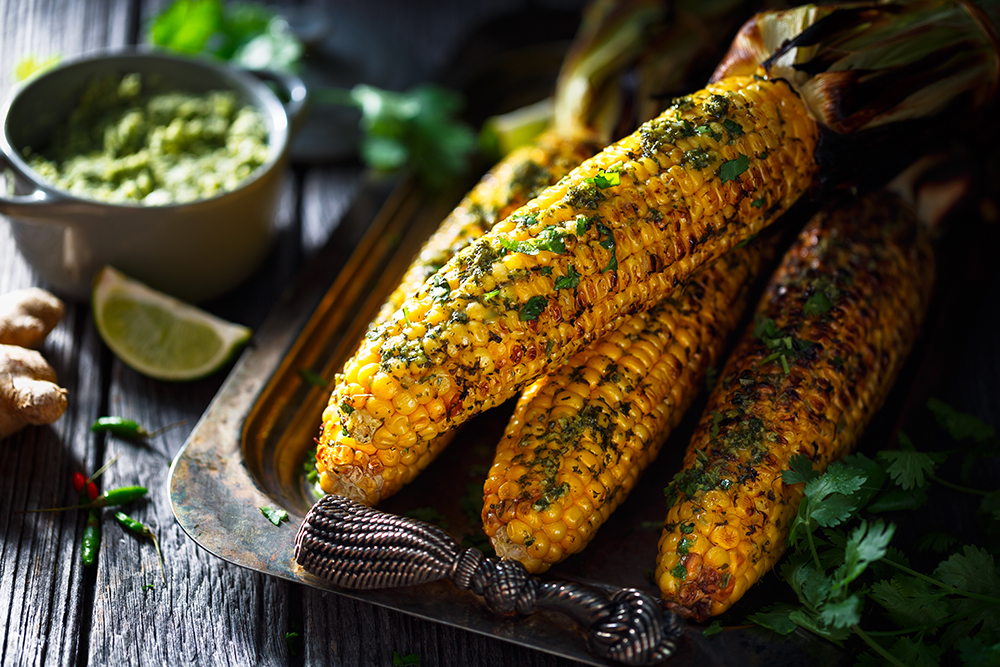Chef Alex Rushmer celebrates sweetcorn, the last of the summer harvest and a deliciously versatile addition to both sweet and savoury dishes
The arrival of the first ears of delightful, tender, locally grown corn is a bittersweet moment for me. It’s a vegetable I adore, one that remains great fun to eat, and always reminds me of lazy summer evenings, with the sun streaming in through the kitchen window and the yellow cobs bobbing happily in a pan of boiling water. But, after the seemingly endless bounty of the summer, sweetcorn is the last of the season’s crops and its inevitable arrival in the kitchen means that autumn nights are drawing in and we are getting ever closer to open fires, woodsmoke and earthy root vegetables. It is perhaps fitting that the sweetest produce comes to life just as summer is sighing towards a close.
The history of maize is a fascinating one, especially for a chef who, as a student, spent many hours poring over archaeology texts concerning the domestication of plants and the emergence of agriculture. Maize, along with rice and wheat, is the third great agricultural success when it comes to the domestication of what once were merely wild grasses. Teosinte – the wild progenitor of modern corn and maize – still grows in South America but its tiny heads bear little resemblance to modern day sweetcorn which has been selectively harvested and planted for several thousand years into the plant we know today.
Other varieties of corn do exist but these are often left to fully ripen (in order to make maize flour for tortillas) or even dry completely (in order to make popping corn) whereas sweetcorn is picked early at what is known as the ‘milk stage’ of plant development. Because the sugars in sweetcorn rapidly begin to convert into starches after picking, it is crucial to cook and eat it as close to harvesting as possible.
I once read that the only acceptable window of time between picking and eating an ear of corn is the length of time it takes for a pan of water to come to the boil. For most of us, this is a little unrealistic but freshness really is paramount – after a day or so, there is a noticeable drop off in the sweetness levels so try to find corn that has been harvested within the previous 24 hours.
‘Some of my finest food memories involve tucking into a steaming ear of corn’
When it comes to cooking sweetcorn, the simplest ways really are the best: boiled in water (seasoned with salt and a little sugar) is perfectly acceptable, but it is when barbecued that it really comes into its own. Some of my finest food memories involve tucking into a charred and steaming ear of corn purchased for a few pennies from a roadside stall in Bangkok or Colombo. Butter is an obligatory addition, as is a grinding of black pepper or maybe a generous dusting of sumac. The final flourish is always a squeeze of lime juice, the acidity somehow accentuating the sweetness of the kernels themselves.
As for more involved recipes, chowder remains a firm favourite, especially when made with simple boiled potatoes and plenty of any one of several cured pork products – bacon and sweetcorn is one
of the all-time best food matches. Shellfish and sweetcorn are also a wonderful pairing, particularly with scallops or crab, or if you fancy heading towards an authentic South American route, try pairing corn with squashes and beans – it’s not for nothing that this trio are widely known as the ‘three sisters’ whilst growing together, and an affinity for each other in the soil transfers brilliantly to the plate.
Finally, don’t forget that given its natural sweetness, it’s an ingredient that can be equally used in desserts, in particular in ice creams or parfaits where it matches perfectly with salted caramel. I’ve enjoyed sweet versions of corn fritters and even experimented with flavouring a panna cotta with the delicious little kernels: that was truly a-maize-ing.

